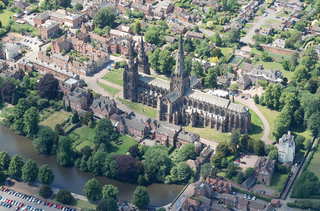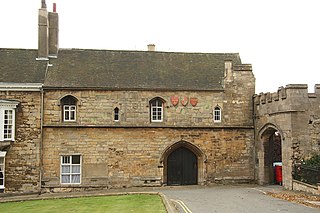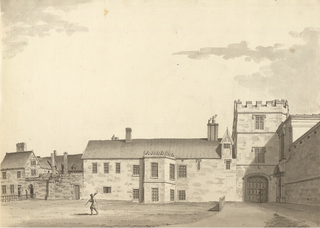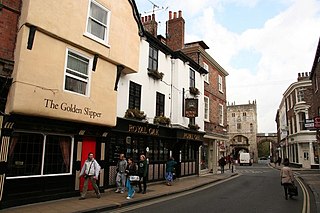
Bedern is a street in the city centre of York, in England, which originated as a college for the vicars choral of York Minster.

Bedern is a street in the city centre of York, in England, which originated as a college for the vicars choral of York Minster.
The Bedern College was founded in 1252, to house 36 vicars choral associated with York Minster. The name "Bedern" meant "house of prayer", and was in use by 1270. It was funded by three grants of land in Yorkshire, one in Hampshire, and the rents of 200 houses in York. It was built on land associated with somebody named Ulphus, which was donated by William of Laneham. The buildings consisted of small houses, a chapel, and a dining hall with kitchens, a buttery and a brewhouse, all built around a green. There was also a record room, and behind the buildings lay a garden and an orchard. In 1396, the site was improved by the construction of a latrine, and a bridge across Goodramgate, so that the vicars could enter the Minster Close without crossing the public street. [1]
In 1574, the vicars stopped dining together, and from 1640, the dining hall was leased out. The college was dissolved during the Commonwealth of England, but reformed afterwards. There were aborted plans to establish a university in the college buildings, while from 1644 until 1730, St Peter's School occupied many of them. By 1700, only five of the houses were occupied by vicars, and during the following century, the houses were replaced by newer buildings, while the latrine was rebuilt as a stable. [1]
By the mid-19th century, the street was one of the poorest in the city. Its population had risen to more than 300, and it was largely occupied by recent Irish emigrants. In 1853, the street was extended to the south-east, to reach St Andrewgate. In 1883, the houses on the north-east side, three of which had Dutch gables, were demolished and replaced by the Ebor Buildings and Hawarden Place, but these in turn were demolished in the 1970s. [1]

The street runs south-east, from Goodramgate to St Andrewgate, accessed at each end via a passageway through a terrace. Bartle Garth joins its south-western side. [1]
Two buildings from the college survive: Bedern Hall, and Bedern Chapel. [1] They are both Grade II* listed buildings, and both lie on the south-west side of the street. [2] [3]
Bedern Chapel was built around 1252, out of magnesian limestone. Internally, it is a single space; a gallery was later added but subsequently removed. Two of the vicars choral, Thomas de Otteby and William Cotyngham, paid for it to be enlarged in the 1340s. The north wall was demolished and rebuilt further north, to make the building larger, and the windows were altered in the east and south walls. In 1393, a new marble altar was consecrated. [3] [1] [4]
In the 17th-century, the chapel became dilapidated, and its east gable was mostly rebuilt in brick. The chapel was renovated in 1757, and in 1787 a new bell was added. The chapel was damaged in a fire in 1819, and the windows in its north wall were then bricked up. The building was repaired in 1831, but by 1859 it was again in disrepair. By 1925, its north wall was leaning and had to be stabilised. In 1961, its roof was removed and the walls were lowered, the materials being stacked inside and the building being left as a ruin. It was later restored, and has since housed the York Glaziers' Trust. [3] [1] [4]
Bedern Hall is thought to date from the mid-14th century. Its north-west and end walls are of limestone and date from this period, although they incorporate some reused 12th-century stones. The south-east wall was later rebuilt in brick, but retains some 14th-century timber framing above. Its scissor-truss roof also survives. The hall had a service wing to the south east, including a pantry, buttery and, connected by a passageway, a kitchen. This wing was demolished in 1879. [2] [1]
After the dissolution of the college, the hall served in turn as a butcher's, a baker's, and a pork pie maker's curing hall. By the 1960s, the hall was derelict. Its site was excavated by the York Archaeological Trust in 1977, and in 1984, the hall was restored and an extension was added. It is now jointly owned by the Company of Cordwainers, the Gild of Freemen and the York Guild of Building, and served as a venue for community events, conferences and weddings. In May 2021, the venue began opening regularly to the public, with exhibitions and tours showcasing the heritage of the area. [2] [1] [5]
York had around 45 parish churches in 1300. Twenty survive, in whole or in part, a number surpassed in England only by Norwich, and 12 are used for worship. This article consists of a list of medieval churches which still exist in whole or in part, and a list of medieval churches which are known to have existed in the past but have been completely demolished.

Leeds Minster, or the Minster and Parish Church of Saint Peter-at-Leeds is the minster church of Leeds, West Yorkshire, England. It stands on the site of the oldest church in the city and is of architectural and liturgical significance. A church is recorded on the site as early as the 7th century, although the present structure is a Gothic Revival one, designed by Robert Dennis Chantrell and completed in 1841. It is dedicated to Saint Peter and was the Parish Church of Leeds before receiving the honorific title of "Minster" in 2012. It has been designated a Grade I listed building by Historic England.

Ecclesfield Priory was a religious house of Benedictine monks, lying in the village of Ecclesfield, north of Sheffield in Yorkshire, England.

Vicars' Close, in Wells, Somerset, England, is claimed to be the oldest purely residential street with original buildings surviving intact in Europe. John Julius Norwich called it "that rarest of survivals, a planned street of the mid-14th century". It comprises numerous Grade I listed buildings, comprising 27 residences, built for Bishop Ralph of Shrewsbury, a chapel and library at the north end, and a hall at the south end, over an arched gate. It is connected at its southern end to the cathedral by a walkway over Chain Gate.
William Camidge F.R.H.S. (1828-1909) was a British solicitor and author based in York. He wrote histories of Methodism and a biography of the painter William Etty. He was a Royal Historical Society, and a Primitive Methodist associated with Elmfield College.

The Cathedral Close is a historic set of buildings surrounding Lichfield Cathedral in Lichfield in the United Kingdom. The Close comprises buildings associated with the cathedral and the clergy which encircle the cathedral. The Close grew up around the cathedral during medieval times and today some medieval buildings remain in the Close but the majority of buildings date from the 17th, 18th and 19th centuries.

The Vicars’ Court or Vicars’ Choral in Lincoln, is situated in the Minster Yard to the south of Lincoln Cathedral. It was founded as a college of priests by Bishop Sutton in the late 13th century. These priests would take services in the Cathedral in the absence of the Prebendaries. The Vicars‘ Choral of Lincoln is one of eight such colleges in England, and it is also one of the earliest and best preserved. The great majority of the building survives. By 1305 the hall, the kitchen and certain chambers were finished. In 1328 lay brothers were admitted and further houses were built for them During the English Civil War, the buildings were badly damaged and afterwards were converted into four houses.

The Old Deanery, Lincoln was the official residence of the Dean of Lincoln. It was a spacious building set around a courtyard. The Deanery is thought to have been started in 1254 by Richard de Gravesend, who became Dean in that year and Bishop of Lincoln four years later. The hall stood on the north side of the court. The great kitchen, the buttery and other offices stood in the same range of buildings. They were extensively damaged during the English Civil War and rebuilt after 1660. The southern entrance tower or Flemyng tower was built by Dr Robert Flemyng and his arms were on both the north and south fronts of the tower. The Deanery was pulled down in 1847 and replaced by the present building by William Burn. This was to become the Cathedral School and later the Minster School. In 2017 plans to convert the building into a visitor and education centre for Lincoln Cathedral were announced.

King's Square is an open area in the city centre of York, in England. It is popular with tourists, who are often entertained by buskers and street performers. Nikolaus Pevsner notes that "the square has trees, which distinguishes it". The York's Chocolate Story attraction lies on the western side of the square.

Goodramgate is a street in the city centre of York, in England.

St Sampson's Church is a former parish church in the city centre of York, England. It lies on Church Street, near St Sampson's Square.

Aldwark is a street in the city centre of York, in England.

Petergate is a street in the city centre of York, in England. It is divided into High Petergate and Low Petergate. The well-known view of the Minster from Low Petergate is described by the City of York Council as "excellent".

Ogleforth is a street in the city centre of York, in England.

30 and 32 Goodramgate and 11 and 12 College Street is a Grade II* listed building in the city centre of York, in England.

College Green is an open space in the city centre of York, England.

Grape Lane is a street in the city centre of York, in England.

Minster Yard is a street in the city centre of York, England. It runs along the southern, eastern and northeastern sides of York Minster, for which it is named.

The Minster Close or Minster Precinct is the area surrounding York Minster. It first appeared in records from the late 13th century, when a wall was constructed around it.

Chapter House Street is a street in the city centre of York, England, connecting Ogleforth and Minster Yard.